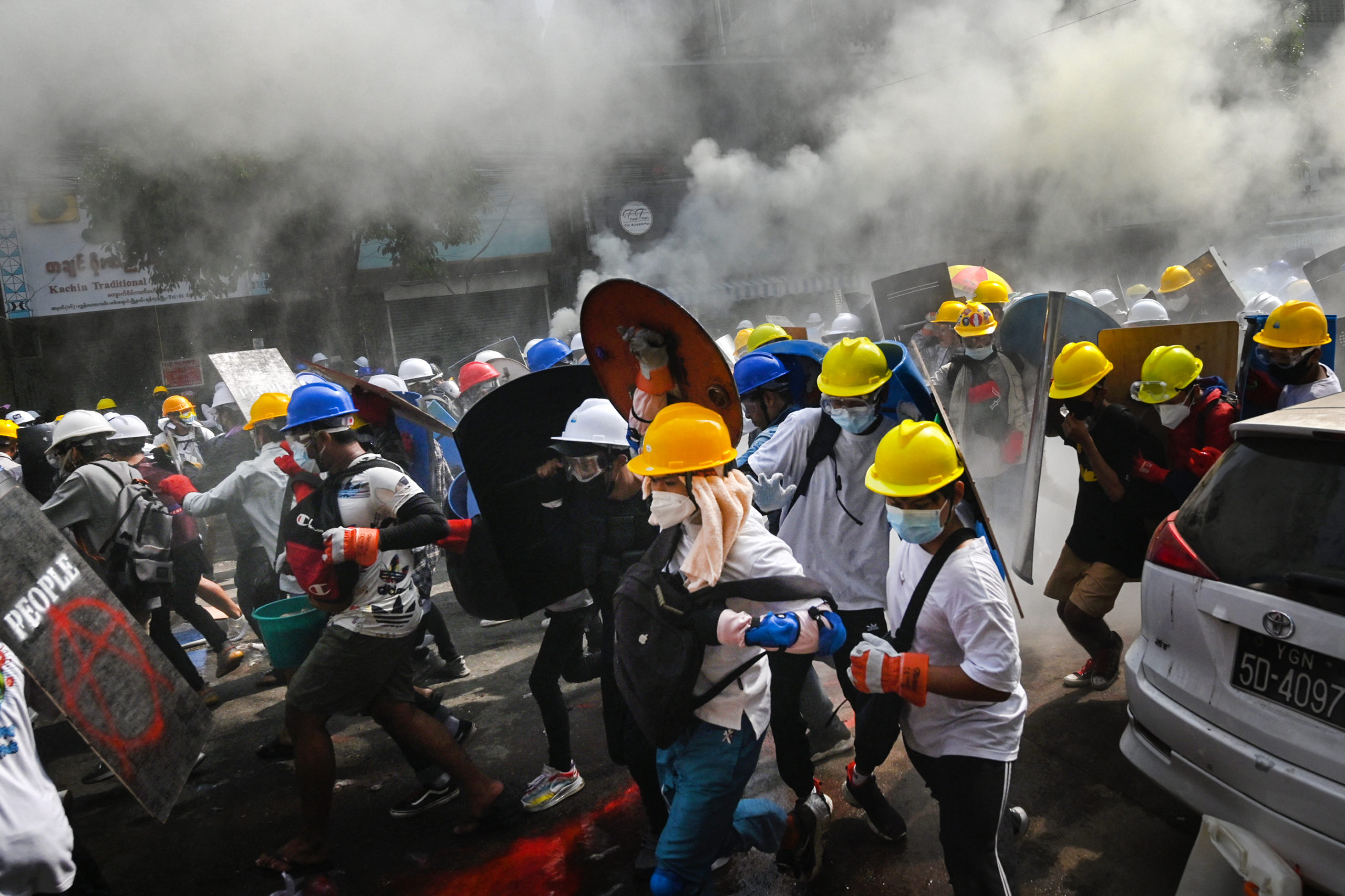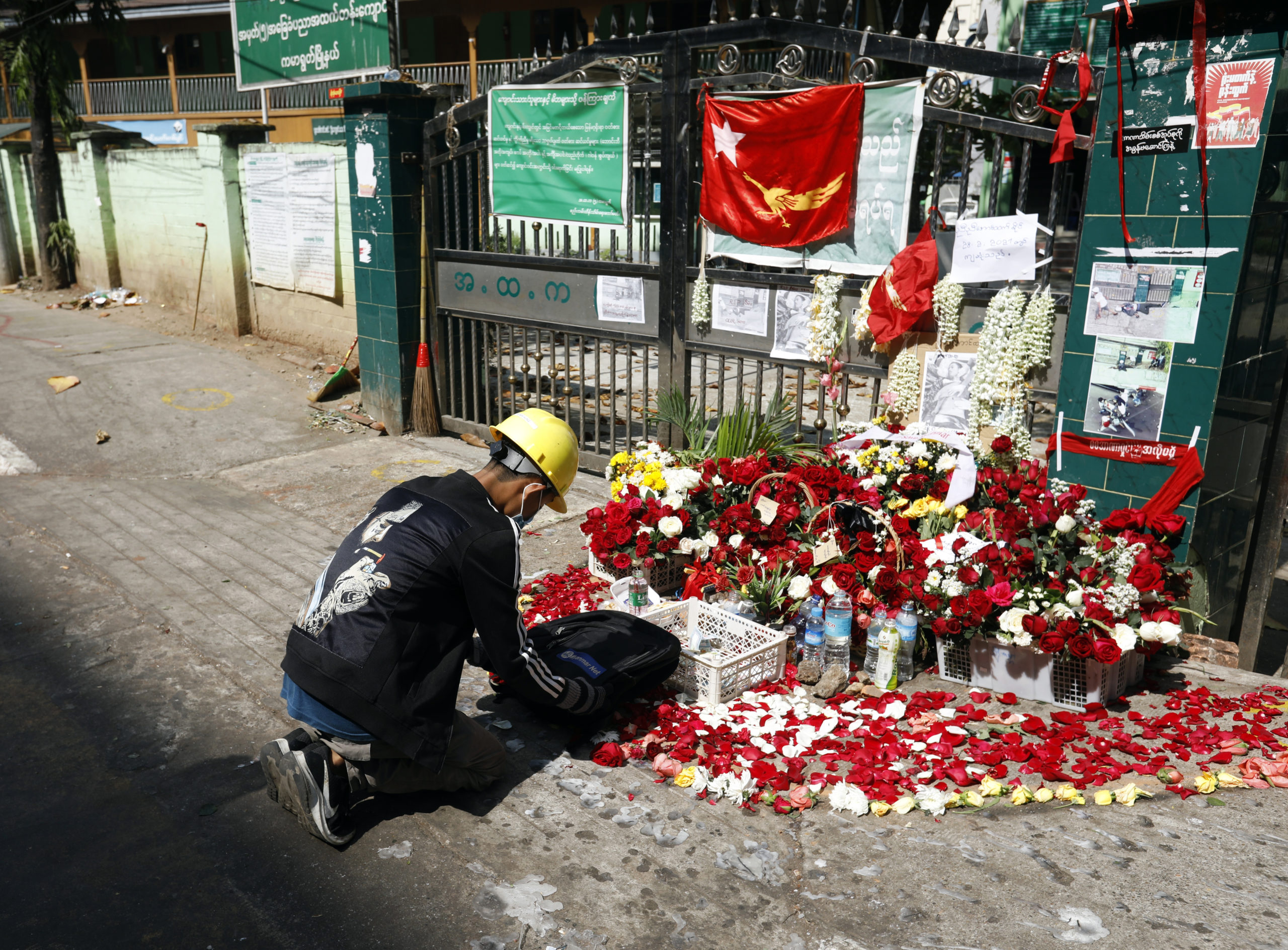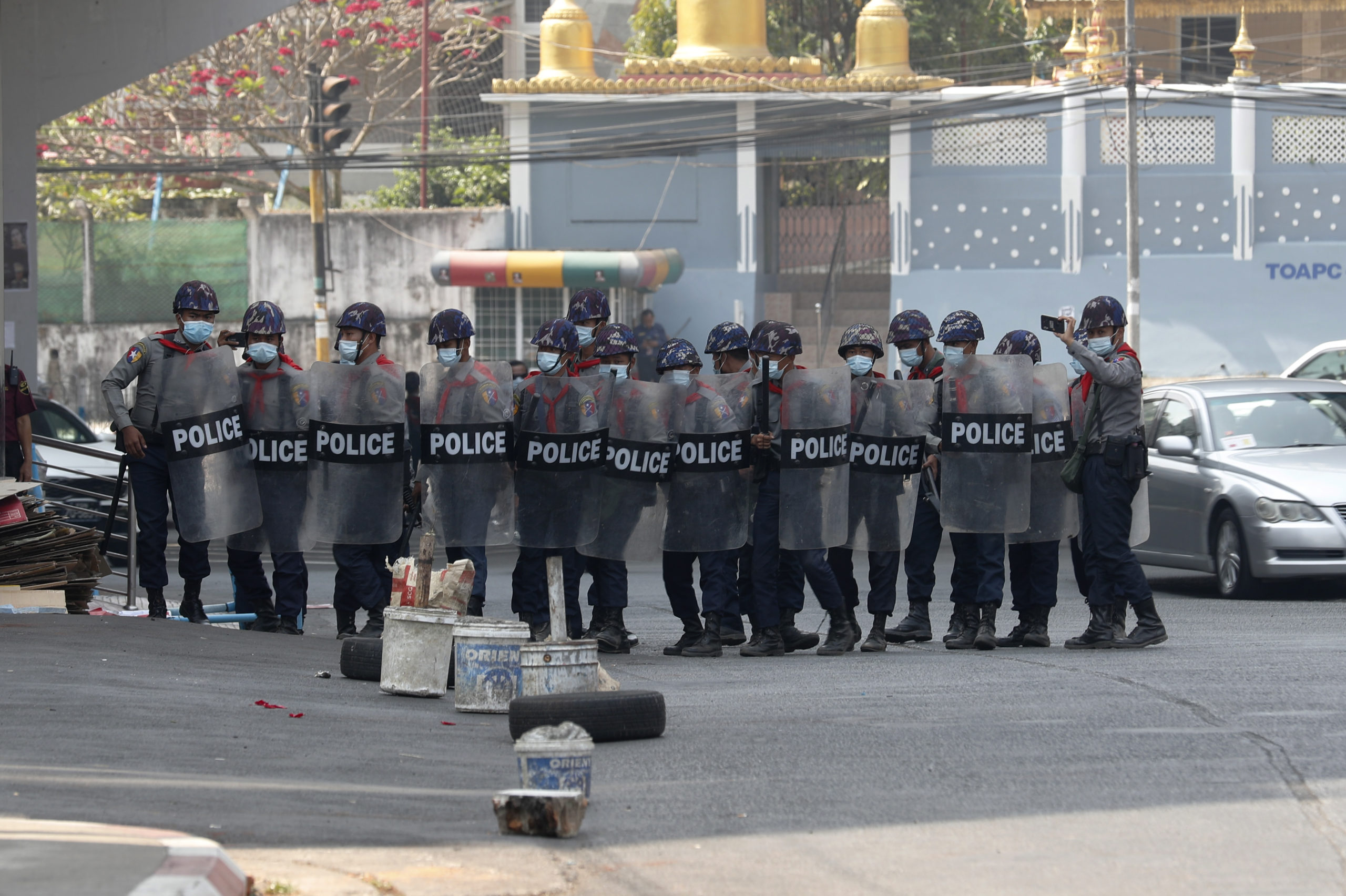“I was wearing the press vest and helmet, and the soldier looked me in the eye, then he shot straight at me. We caught the airflow of the bullet just beside our faces,” recalled Hnin Yadan Zaw.
The journalist, working for an international news agency, recounted her near-death experience when confronted by soldiers while covering an anti-military protest in Yangon earlier this week. This kind of encounter has become an all too familiar occurrence for many journalists working on the frontlines documenting the aftermath of the coup.
Racing down the narrow side streets of Myanmar’s major cities to dodge open fire, unsure of whether the bullets are real or rubber, journalists are facing a grim reality that many never imagined possible – even in a country well-accustomed to military strongholds.
Aung Shin, an editor with Myanmar Now in Yangon, has spent years navigating Myanmar’s complex media landscape in both his current role as well as his former position as editor and chief business reporter at the Myanmar Times.
“The military junta never liked the press. It was already dangerous, we knew this. As soon as the coup happened, we prepared for the worst,” he told the Globe. “The junta security forces are mainly trying to arrest journalists on the ground whoever is there, they don’t care which media you are from.”
Since the coup on February 1, the military has deployed soldiers to cities and towns all across the country, in an effort to push back against rising opposition movements resisting the new regime. Equipped with heavy weaponry – rifles, tear gas and stun grenades – soldiers have resorted to extreme force to disperse, terrorise, and even kill those on the streets. Journalists, far from neutral commentators of the unrest, have not been spared from the violence.
“On the road there are lots of police and military trucks. If they know we are from the press, we will be arrested or even shot at,” says Nyein Chan Naing, a photojournalist with the European Pressphoto Agency. “One of my colleagues working for another agency was approached by the police, but when he showed his press badge they shot him with rubber bullets, at least four or five, and he got injured in the chest and back.”
In an effort to stifle reporting and limit news of widespread violence reaching international audiences, the military has brazenly targeted the press with violence and arrest in recent weeks. To date, at least 50 protesters have been killed by the military and at least 1498 have been arrested and detained in undisclosed locations. Of the detained, 34 are journalists as of publishing, according to the Assistance Association for Political Prisoners.

Having been on the scene since the early hours of the coup on February 1, it was journalists in Naypyidaw, the country’s ghost-town capital, who witnessed the events firsthand before and as they unfolded, with great effort to get the word out even amidst internet blackouts.
Ei Ei Toe Lwin, the editor for the Burmese section of Frontier Myanmar, was in Naypyidaw when the military toppled the civilian government, having travelled north to cover what was expected to be the opening of a new session of parliament.
“On the evening of January 31, I got a call from my source he said, ‘the night will be long’,” she told the Globe. “I understood what he meant. When I got back to my hotel, I immediately informed my editors and reported this possible information of what would happen that night.”
With internet blackouts in place for the first hours of the coup, Ei Ei Toe Lwin and her colleagues gathered information as best they could, then waited for cellular data to be restored to report what was happening to their counterparts in Yangon.
“We listened to the news announcements from the taxi drivers who were listening to the recordings on their phones. Then we finally got the detailed information of what had happened, but we could only publish the news around 10:30 or 11am because before that time the internet was cut.”
Internet blackouts interrupting the reporting process would become routine around the country in the subsequent weeks – first rolled out sporadically then ritualised each night to instill unease and fear among a population waiting anxiously in the dark of night.
The nighttime internet affects people the most. We cannot know what is going to happen, knowing that we cannot reach out to anyone during the long hours of blackout
“The nighttime internet affects people the most. We cannot know what is going to happen, knowing that we cannot reach out to anyone during the long hours of blackout,” said Hnin Yadan Zaw. “The worst thing is there is nothing we can do about it because the military controls all telecommunications.”
For many journalists working in Myanmar, the spotty internet during the day and the full blackouts in the evening have been somewhat circumvented by using alternative modes of communication, such as imported SIM cards from Thailand. But with access only available to a small minority, cross-border SIM cards can only do so much, said Myanmar Now’s Aung Shin.
“More people are using Thai SIM cards, so we all have that and we use them. But even then, you’re the only one who has internet connection, the rest of the people don’t, so you can’t do that much,” he said. “For reporters, you just use [the foreign SIM cards] to make sure you’re safe and prepare for more reporting in the morning.”
In ethnic areas, local media outlets in states like Kachin and Shan have long-since covered the military’s violence and know all too well the dangers of reporting in a conflict zone. However, journalists from these areas say that the widespread nature of violence in their cities in response to the protests has startled even them.
Sam Naw is the managing editor of the Kachin News Group (KNG), an independent news agency in Myitkyina. Established in 2003, KNG was the first mainstream news outlet in Kachin state, reporting on the long history of ethnic violence in the region where confrontations between ethnic armed organisations (EAOs) and the military have long been commonplace.
“There has been lots of fighting in Kachin state, but this was almost always in remote areas, far from the cities so reporters could cover the human rights violations and war crimes [remotely] through spokespersons from the EAOs and the victims’ families, and the reporters could be easily protected,” he said. “But following the coup, the crackdowns are now happening publicly in the middle of the towns and journalists are being targeted.”
For Hnin Yadan Zaw who had also previously covered conflict in ethnic areas, the scale of the violence against these current protest movements is unlike anything she has seen before.
“I have been to so many hostile places in the past. I have been across the country to war zones in Shan state and in Rakhine state, but I never had to actually experience violence in front of my eyes so closely on the daily,” says Hnin Yadan Zaw. “This is the first time I feel truly horrible. During the nighttime, in my mind I keep seeing the soldiers coming after the protesters.”
If they arrest us they might not release us like other protesters [because we are journalists]. Right now we are hiding in people’s houses, we cannot easily go out on the road and take videos
Sandy, a senior manager with one of the leading local media outlets in Shan state, whose name has been changed for her safety, says that ethnic media outlets are somewhat secure in their isolation from the news stations operating in major cities, both in terms of language and geography.
“News at the national level is more dangerous than local media like us. Because national media is reporting in the Burmese language but we are reporting in our local language, Shan, which is different,” says Sandy. “And our local media is not as popular as the national level media so while national media has had reporters arrested already, this hasn’t happened to us yet.”
But while this obscurity may afford some protection now, Ma Ei, a reporter with the same news agency in Shan state, whose name has been changed for her safety, fears the situation could rapidly change at any moment with the military’s long history of unfettered violence in the region.
“I fear that I will be arrested because the situation is getting worse day by day,” she said. “If they arrest us they might not release us like other protesters [because we are journalists]. Right now we are hiding in people’s houses, we cannot easily go out on the road and take videos.”

Among the mounting number of journalists arrested since the beginning of the coup, one of the most publicised and violent detentions was of Kaung Myat Hlaing, a reporter with the Democratic Voice of Burma (DVB). After curfew on March 1, during a violent night raid that was live streamed, soldiers arrived at Kaung Myat Hlaing’s apartment in Myeik, beating him and throwing rocks at his head as they brought him into custody.
Aye Chan Naing is the executive director and chief editor of DVB. Stuck in Norway, blocked from returning to Myanmar since the coup, he told the Globe about the uncertainty that still looms around his detained reporter’s wellbeing.
“We just learned that they have taken him to a military base in Myeik, where he was arrested and where he was living,” says Aye Chan Naing. “We don’t know his safety or his well being, we don’t know whether he has been beaten or tortured, we don’t know any of this.”
Myanmar Now’s Aung Shin similarly recounts the arrest of one of his reporters, Kay Zune Nway, who was detained on February 27 in Yangon and has not been heard from since.
“Kay Zune Nway was holding the camera and recording a live stream, then the military approached the protesters and they used tear gas so everyone fled and ran away. But she could not escape so she was arrested by the policeman,” he said.
Myint Aung is one of the lawyers representing Kay Zune Nway, as well as Aung Ye Ko – a reporter with 7 Day News, a weekly Yangon-based newspaper published in Burmese – who was similarly arrested for covering protests in Yangon on February 27.
Myint Aung told the Globe that both reporters are being held at Insein Prison in Yangon. As of publishing, he has been barred from any direct contact with either journalist, but has been notified by the authorities that both are in good health. But without direct communication, it remains impossible to verify the accuracy of this.
“The police mentioned charges under article 505a of the criminal code and have notified us that both journalists will be detained until their court dates on March 12,” said Myint Aung, referring to the part of the criminal code pertaining to any action that is claimed to disrupt the duties of any officer or soldier. Under this charge, the journalists could face up to two years in prison.
“I tried to contact them inside, but we are still waiting for a reply from the authorities.”

While journalists have become targets of the military’s crackdown operations, working for higher-profile news outlets like DVB and Myanmar Now affords a certain level of protection – particularly the quick employment of legal services if needed.
However, for freelancers, who lack the backing of an established network, they are left to fend for themselves.
“It’s more dangerous for freelancers than other media because if we are arrested or if we get an injury we don’t have any provisions or any agency that can protect us,” a Burmese freelance journalist based in Yangon told the Globe, asking to remain anonymous.
“There is less responsibility to protect our rights.”
Photojournalists similarly face disproportionate risk as, unlike their news writer counterparts, their cameras make it difficult to blend into the crowds when covering the protests, according to EPA photographer Nyein Chan Naing.
“When we go out, we do not take out our camera, we keep our equipment in our backpack. We only take out our cameras when we are on the side with the protesters, away from the military,” Nyein Chan Naing said. “If the military sees me take a photo of them, they will arrest me.”
On February 28, Shin Moe Myint, a 23-year old psychology student who was covering the protests in Yangon as a freelance photojournalist, was severely beaten and arrested by seven policemen while trying to photograph the demonstrations. After being detained for several days, she was finally released on March 2.
Whenever female journalists pass by security forces, especially women of my age, they will harass us. The other day one of my female colleagues was told by a soldier on the pavement ‘if you are helping out the protesters you will get raped and pregnant
As a female reporter, this kind of abuse is not uncommon as soldiers have resorted to calling out menacing remarks towards women, both journalists and protesters, according to Hnin Yadan Zaw. While male journalists have also been targeted with passing comments, the slurs and threats directed at their female counterparts are particularly virulent in a country with a long history of military-perpetrated sexual violence.
“Whenever female journalists pass by security forces, especially women of my age, they will harass us. The other day one of my female colleagues was told by a soldier on the pavement ‘if you are helping out the protesters you will get raped and pregnant.’”
“Whenever I pass by the soldiers it gives me chills because these are the same troops who raped women in Rakhine state so I believe that will actually do what they say.”
Given the risk, freelancers and contract journalists alike have taken to moving between different locations to deter tracking. Media outlets are also omitting bylines on articles to minimise controversial content being traced back to any specific reporter, and many have reduced the number of staff they send out onto the streets. But with limited resources and mounting arbitrary violence, there is only so much that can be done.
Beyond the safety of individual journalists, for major news outlets there is also fear of military-ordered closures. And with these threats on the horizon, some news outlets, like KNG and Myanmar Now, have even begun exploring moving their offices outside of Myanmar – possibly into neighbouring Thailand where they can maintain proximity to events with less immediate risk.
But, for now, with the military restricting cross-border movement, shifting operations could prove challenging. Instead, attention remains focused on covering events as they unfold on the ground, amidst sensationalised reports and campaigns of misinformation, to share real-time accounts with a global audience.
“This is what I am supposed to be doing. I truly want the international community to see what I am seeing right now because this is something that people with morals would never do,” said Hnin Yadan Zaw, referring to the unprovoked force being used against protesters.
“People are describing this as a war zone, but this isn’t true. It’s just people – civilians – who do not have any weapons or anything that are being slaughtered on the streets in front of our eyes.”


